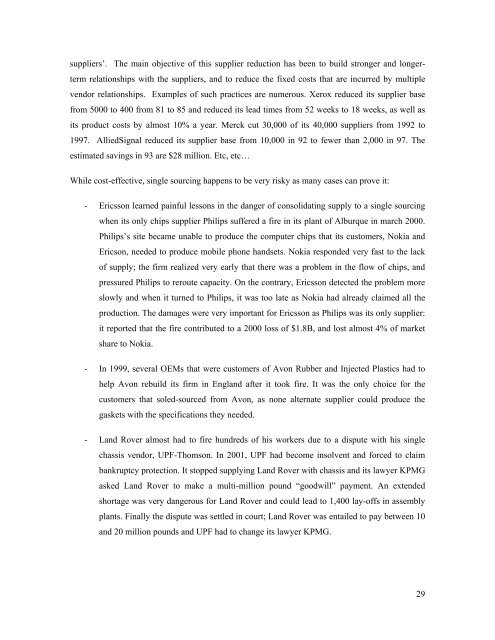Managing Risks of Supply-Chain Disruptions: Dual ... - CiteSeerX
Managing Risks of Supply-Chain Disruptions: Dual ... - CiteSeerX
Managing Risks of Supply-Chain Disruptions: Dual ... - CiteSeerX
Create successful ePaper yourself
Turn your PDF publications into a flip-book with our unique Google optimized e-Paper software.
suppliers’. The main objective <strong>of</strong> this supplier reduction has been to build stronger and longertermrelationships with the suppliers, and to reduce the fixed costs that are incurred by multiplevendor relationships. Examples <strong>of</strong> such practices are numerous. Xerox reduced its supplier basefrom 5000 to 400 from 81 to 85 and reduced its lead times from 52 weeks to 18 weeks, as well asits product costs by almost 10% a year. Merck cut 30,000 <strong>of</strong> its 40,000 suppliers from 1992 to1997. AlliedSignal reduced its supplier base from 10,000 in 92 to fewer than 2,000 in 97. Theestimated savings in 93 are $28 million. Etc, etc…While cost-effective, single sourcing happens to be very risky as many cases can prove it:- Ericsson learned painful lessons in the danger <strong>of</strong> consolidating supply to a single sourcingwhen its only chips supplier Philips suffered a fire in its plant <strong>of</strong> Alburque in march 2000.Philips’s site became unable to produce the computer chips that its customers, Nokia andEricson, needed to produce mobile phone handsets. Nokia responded very fast to the lack<strong>of</strong> supply; the firm realized very early that there was a problem in the flow <strong>of</strong> chips, andpressured Philips to reroute capacity. On the contrary, Ericsson detected the problem moreslowly and when it turned to Philips, it was too late as Nokia had already claimed all theproduction. The damages were very important for Ericsson as Philips was its only supplier:it reported that the fire contributed to a 2000 loss <strong>of</strong> $1.8B, and lost almost 4% <strong>of</strong> marketshare to Nokia.- In 1999, several OEMs that were customers <strong>of</strong> Avon Rubber and Injected Plastics had tohelp Avon rebuild its firm in England after it took fire. It was the only choice for thecustomers that soled-sourced from Avon, as none alternate supplier could produce thegaskets with the specifications they needed.- Land Rover almost had to fire hundreds <strong>of</strong> his workers due to a dispute with his singlechassis vendor, UPF-Thomson. In 2001, UPF had become insolvent and forced to claimbankruptcy protection. It stopped supplying Land Rover with chassis and its lawyer KPMGasked Land Rover to make a multi-million pound “goodwill” payment. An extendedshortage was very dangerous for Land Rover and could lead to 1,400 lay-<strong>of</strong>fs in assemblyplants. Finally the dispute was settled in court; Land Rover was entailed to pay between 10and 20 million pounds and UPF had to change its lawyer KPMG.29
















